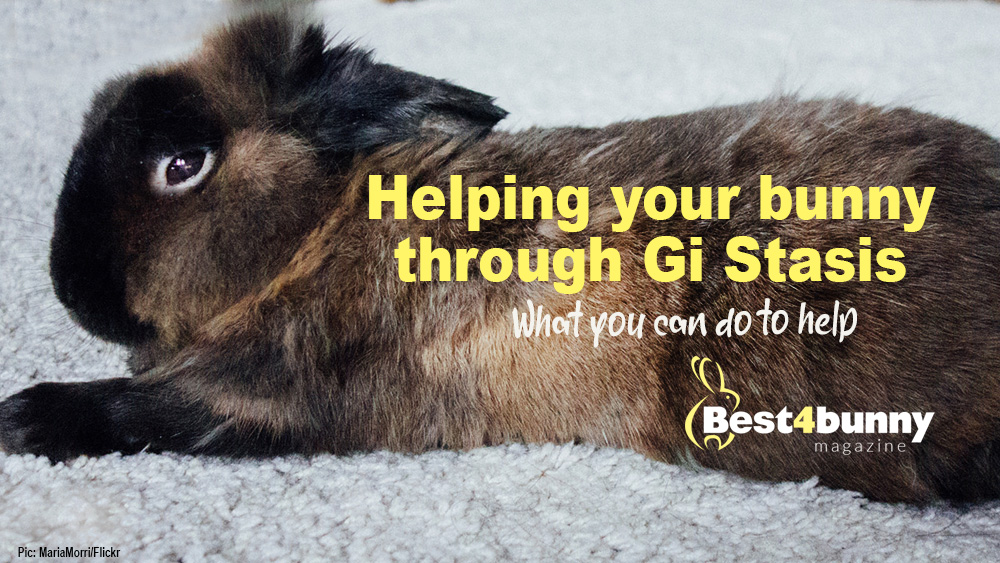
GI stasis in rabbits is also known as the silent killer. The first 12 hours are crucial. You need to act quickly to save your rabbit. This blog is here to help you, help your bunny. We have collated some great tips from ourselves and other rabbit parents, on what can be done the minute you see the very ‘FIRST’ signs of GI stasis in your rabbit’s behaviour. We wish to share them, in the hope they help save many bunnies.
###Please note: Always contact your vet urgently, if you are unsure what to do, or if your rabbit is showing signs they are in great pain and have been suffering for sometime.
###This blog helps you to…
* Spot the very first signs/ symptoms of GI Stasis
* Act quickly the minute you notice the very first signs/symptoms
* Nurse your rabbit through GI Stasis
* When to call the vet
* Help to prevent it happening again
##Look out for any of these early symptoms
**Act quickly the minute you spot them! Acting early is key!**
* Stopped eating
* Stopped pooping (no recent droppings)
* Not interested in treats
* Difference in behaviour
* Sitting in an unusual place
* Laying in litter tray
* Can’t seem to settle
* Ears slightly back
* Eyes slightly squinting
* Hiding away
* Sitting funny
* Just not themselves
* Let’s you pick them up, when usually wouldn’t
**Check their tummy! Does it feel larger and harder than normal?**
##Signs they have been suffering a while – and you should call the vet urgently:
* Very loud constant grinding of teeth
* Very lethargic
* None responsive
* Breathing heavily
* Mouth a funny shape
* Sitting facing a corner
##What you can do to help your rabbit…
**Remember: Acting quickly & catching it early is key!**
**If you catch GI Stasis quick enough, rabbits can snap out of it within a few hours.**
**As soon as you notice the early stages of GI Stasis…**
* Syringe feed them immediately with 1ml of Infacol (or if outside the UK – other Infant drops that contain Simethicone).
* Gently massage their stomach, to help get their gut moving again.
* Help relief gas by placing your bunny on a table or the floor, facing towards you and place your hands underneath them at the joints of their back legs. Slowly and gently lift their back end up off the floor so their back legs stretch out to full length. Hold for about 10 – 15 seconds. Lean forwards while you do this, to help stop them moving forwards. Repeat this a couple more times. DO NOT perform this procedure if your rabbit gets stressed from you doing this or they react like it causes them pain.
* Encourage them to move about. They may not want to, but this will really help a lot.
* Keep them warm.
* Keep doing the above and repeat 1ml of Infacol every hour for next 3 hours.
**You need to get them eating & pooping again as quickly as possible.**
* Offer them all their favourite foods to tempt them to eat. It is likely they will show no interest in wanting to eat, so try waving the food in front of their faces gently. Keep doing this until they get annoyed with you and that is when they are likely to bite at the food & hopefully they may digest some. Keep trying this, but don’t stress them out too much.
* Freshly picked Dandelions, grass, bramble leaves and milk thistle really appeal to sick bunnies and helps to get them eating again. They really help with their digestive system, too.
* Fresh herbs like parsley, basil and lemon balm also help to encourage a rabbit to start eating again.
* Make sure they have lots of fresh water (bowls and bottles) to help encourage them to drink. Keeping them hydrated is important. You can syringe feed them a little water, but use a 1ml syringe, so you are only giving them a little at a time. If you gave them too much it could go into their lungs. Or try dropping a little water over their vegetables, so that they consume droplets of water whilst eating the vegetables.
**IMPORTANT: If there is no improvement within a few hours, or if they have got noticeably worse within a short space of time, then you need to take them straight to the vet. If it is out of hours, you should call the emergency vet.**
###What to do when you see signs of improvement…
If they seem better in themselves & they have eaten a little, continue to nurse them and that includes through the night too!
* Still encourage them to run around.
* Still encourage them to eat.
* Still give gentle tummy rubs.
* Listen to their tummy for gurgling sounds. Good news if you hear some gurgles.
* Keep doing this until they are eating and producing droppings again & showing signs of normal behaviour.
###When to syringe feed them food…
* Do not syringe feed them food mixtures until you are certain there is no blockage!
* Have they produced any droppings in last hour or so? If not, then continue with all of the above in trying to encourage them to eat on their own. Do this until you see some droppings.
* You need to check they have no blockage before syringe feeding food. If there have been no droppings for a few hours, then contact your vet & have them check for a blockage.
* If they have produced some droppings, then you know there is no blockage and you can start to syringe feed them some food.
* Make a food mixture by adding hot (not boiling) water to a small amount of their pellets & mashing them up. Add more water to make the solution thin enough for syringe feeding. Sprinkle in some critical care, if you have some & syringe feed slowly to your rabbit.
**Even when you get them to eat and they produce droppings again, you should still keep a very close eye on them. Full recovery from a bout of GI Stasis can take days, sometimes weeks.**
### When to call the vet…
* Call your vet the minute you feel your rabbit needs help and you are unsure what to do.
* Call your vet if you feel your rabbit is no longer showing the first signs, but signs they have been suffering a while.
* Call the vet the minute they show they are in severe pain.
* Call the vet if you see no improvement after nursing them for an hour or two yourself.
### What to do when your rabbit is ‘almost’ back to normal again!
**After a rabbit has suffered with GI Stasis, getting them to eat ‘normally’ again is key & very tricky.**
* They may eat some hay, they may eat some vegetables or treats, but many don’t show an interest in pellets again straight away. This can take a few days. As long as they are eating something & producing droppings, don’t worry, they will go back to their pellets in time.
* Feed a syringe of mashed up pellets and Critical care on a regular basis throughout the day, until eating normally again.
* Continue to provide lots of extra exercise, provide unlimited amounts of good quality fresh hay, provide their favourite vegetables & keep brushing your rabbit every day.
* Keep providing foods that help improve their digestive system, like freshly picked dandelions, grass, bramble leaves and milk thistle.
### Help stop GI Stasis happening again!
**GI stasis is a condition and not an illness and is always secondary to some other health issue.**
* If you are unsure of what caused the GI Stasis, then talk to your vet & have them health check your rabbit, to find out what could of caused it.
* Observing your rabbit and knowing when they are behaving strangely is key!
* Feed Oxbow digestive support or Protexin Pro-fibre pellets on regular basis to help improve your rabbits digestion.
* Massaging their belly gently, during snuggles every now & then will help get them used to belly massages for when they are unwell.
* Lack of exercise in the winter can contribute to GI Stasis. Where possible encourage them to exercise out in the garden, like they do in the summertime, but supervised of course. If it’s cold outside & they are house rabbits, keep to 10 minute sessions only, or make a new playground area indoors, to keep them active during the winter months.
* Check homes are free from drafts and that they are not chewing wood/carpet or cardboard and digesting it. If you feel they are digesting items they shouldn’t be, then remove them immediately.
* Have their teeth checked regularly by your vet, for any dental issues.
* Always introduce new foods slowly.
* Brush them every day to stop them digesting too much fur!
* Don’t stress your rabbits out!
* Make sure they always have access to plenty of fresh water!
* Make sure they always have access to unlimited amounts of fresh hay!
* Never stop checking your bunnies for any signs of GI Stasis, as it strikes fast. Carry out regular health checks.
* If you see early signs…
Don’t think “I’ll see how they are in the morning” or “see how they are when I get home from work”. You need to act quickly. If you cannot stay at home to keep an eye on them and nurse them, then contact your vet.
* Know your bunny and have some emergency supplies ready at the slightest change in behaviour. Talk to your vet about what medications you can keep at home and what amounts you can give your rabbit. Also, ask your vet for some 1ml syringes. It’s always good to have a supply of these 1ml syringes at home.
* If you notice your rabbit acting weird, but you are not quite sure anything is wrong, then bring out the treats! If they don’t show any interest in treats like they normally do, you know something is wrong.
* If you think something is up, do not hesitate to go into ‘Stasis mode’. The sooner you catch it and act, the better chance they will have of recovering.
**We hope this blog helps save many bunnies that show the very first signs of GI Stasis**



